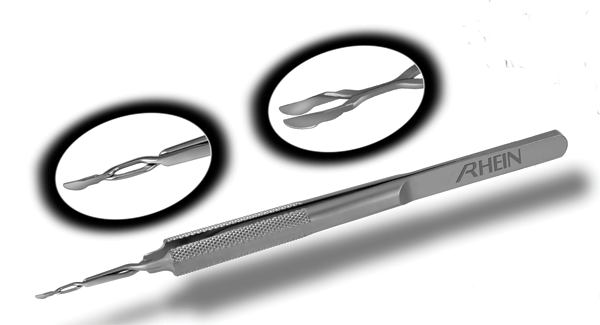Rhein Medical has introduced a new Aguilar Pre-Chopper (Product #8-01349), developed in coordination with Roberto Aguilar, MD. Rhein says the instrument is ideal for pre-chopping grade III, IV and V cataracts. It features blades that are smaller, to easily pass through a 2.0 mm phaco incision, and beveled to allow pre-chopping with both anterior and posterior surfaces.
The pre-chopper is reusable, autoclaveable and made in the

Accutome Simplifies Toric IOL Placement
Accutome offers the Donnenfeld Irrigating Hook developed in conjunction with Eric D. Donnenfeld, MD, FACS, and designed specifically to facilitate the positioning of toric IOLs, especially once viscoelastic is removed. Making sure toric IOLs are positioned properly helps to improve the patients overall refractive outcome, Accutome says.
The Donnenfeld Irrigating Hook has two irrigating ports positioned at the tip of the instrument. These ports help to open the capsular bag allowing the surgeon to rotate the toric IOL. The hook on the bottom of the instrument gently grabs the haptic for rotation. The design is a major enhancement from other irrigating devices that were never designed to rotate IOLs. The hook is available in a straight or angled tip configuration.
Accutome is offering an introductory special price on the Donnenfeld Irrigating Hook. For information, call 1 (800) 979-2020.
Automation Improves Gulden Field Tester
Gulden Ophthalmics' Automated Confrontation Visual Field Tester is cost-effective, easy to use, fast (both eyes can be tested in less than a minute), and more accurate and sensitive than using finger confrontation methods, the manufacturer says.
The device presents automated, randomized patterns of lit LEDs and the patient is asked to identify the number of lights seen. The eye care professional views the tested eye though the device to ensure fixation on the center and is able to validate the patient's response with the four indicators on the rear panel while the patient identifies the presentations of the random LED pattern on the front.
While gross confrontation visual field testing is rapid and inexpensive to perform and is considered an essential part of a comprehensive eye examination, it has not been standardized, the company says. Clinicians tend to vary targets or testing techniques; targets are typically not uniform and may include fingers (either stationary or oscillating), the palms of the hand, the examiner's face, or illuminated white or colored stimuli.
A controlled study at SUNY State College of Optometry reported that screening with the ACV uncovered visual field loss by being able to detect smaller scotomas, which were missed in patients tested with finger counting confrontation. The study noted that other studies, which have utilized small red objects such as the LEDs used in the ACV, are more sensitive for the detection of both neurologic and glaucomatous field loss than finger or hand methods.
The ACV tester consists of a black unit measuring 12 cm by 17 cm. Four 1.0-mm red LEDs are positioned 11.25 cm apart, which results in an angular separation of 15 degrees when the device is 60 cm from the patient. The tester is powered by two standard AA batteries.
For information, call (215) 884-8105, e-mail [email protected] or visit guldenophthalmics.com.
Pearls From the Deep
Reverse Spin on the Alcon Toric
The Alcon Toric intraocular lens is effective, as the acrylic material is "sticky" and virtually eliminates postop rotation. The downside is that it can be difficult to align with the intended axis.
The common approach is to insert the IOL and spin it just counterclockwise of the intended axis prior to full expansion of the haptics. Evacuate the viscoelastic and then nudge the IOL clockwise onto the axis marked on the cornea preoperatively. At this time the haptics will have contact with the fornices of the capsule and rotation will be difficult.
What to do when you have over-rotated the IOL? It's a long way "around the horn" and not without risk, particularly in hyperopes with a small capsule and a lot of drag due to IOL-capsule contact.
A simple and easy way to back up the IOL (that is, spin counterclockwise) is to place the I/A tip under the superior aspect of the optic and go to irrigation, freeing the IOL optic and haptics from capsular contact. A Bechert rotator through the side port incision on the top of the IOL can spin the IOL in the reverse direction, using the I/A tip as its axis. Spin just to the right of the intended axis, and withdraw the I/A tip. Then, correct a few degrees clockwise to the planned axis.
The "reverse spin" is easier, faster and safer than rotating clockwise an additional 175 degrees with full IOL-capsule contact, and the attendant risks of zonular dehiscence or capsular rupture.











